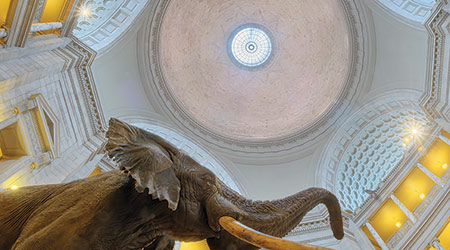'Palaces for the People: Guastavino and America’s Great Public Spaces'

The National Building Museum presents the first major exhibition in the U.S. celebrating one of America’s greatest, yet least known, builders of iconic spaces.
The Guastavino family’s soaring tile vaults grace many of the nation’s most iconic structures including Grand Central Terminal, the Cathedral of St. John the Divine, the Boston Public Library, the U.S. Supreme Court, and the Nebraska State Capitol. Yet the name, the accomplishments, and the architectural legacy of this single family of first-generation Spanish immigrants are virtually unknown. Not only did the Guastavinos help build many great, American public spaces between 1881 and 1962, they also revolutionized American architectural design and construction. Their patented vaulting techniques made it possible for the greatest architects of the day to create the breathtakingly beautiful spaces that represent the nation’s highest ideals and aspirations.
Palaces for the People: Guastavino and America’s Great Public Spaces sheds lights on the story of Rafael Guastavino Sr. (1842-1908), arguably the most influential architectural craftsman working in late-nineteenth and early-twentieth-century America. An established master builder in Barcelona, Guastavino immigrated to New York with his young son, Rafael Jr. (1872-1950), in 1881. His patented tiling system —based on a centuries-old Spanish building method— enabled the construction of self-supporting arches that were simultaneously lightweight but strong, fireproof, and attractive. The construction system interlocked and layered thin clay tiles and quick-setting mortar in highly decorative patterns. Compared to stone or brick vaults which required additional time and materials, Guastavino’s tile vaults were exceptionally economical and highly flexible. Within a few short years, Guastavino’s signature vaulting technique had transformed the American architectural landscape.
This exhibition will feature specially-commissioned, large-scale color photography by Michael Freeman; original Guastavino Company drawings, patents, and advertisements; 3D-printed scale models; immersive videos; a full-scale tiled vault built by masons from the International Masonry Institute; and construction demonstrations. Construction will be filmed using stop motion photography so it can be integrated into the exhibition after construction is complete. The project is organized by 2008 MacArthur Fellow John Ochsendorf, an associate professor at The Massachusetts Institute of Technology’s Department of Architecture and the author of Guastavino Vaulting: The Art of Structural Tile (Princeton Architectural Press, 2010).
Buy tickets online. National Building Museum opening hours are Monday–Saturday (10 am – 5 pm) and Sunday (11 am – 5 pm).
- Architecture
- Washington, D.C.
- Mar 16, 2013 – Jan 20, 2014
Venue
National Building Museum, 401 F Street Northwest, Washington, DC 20001
View on Google MapsMore information
Credits
The exhibition is presented with support from the National Endowment for the Humanities (NEH), the Massachusetts Institute of Technology (MIT), the International Masonry Institute (IMI), the International Union of Bricklayers and Allied Craftworkers, ZGF Architects LLP, and SPAIN arts & culture.
Image: The Guastavino tile dome at the Smithsonian Institution’s Museum of Natural History, Washington D.C. Architects; Hornblower and Marshall (1909). Photo by Michael Freeman.